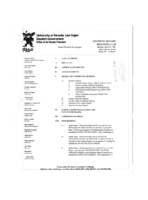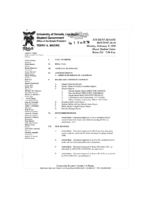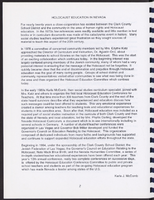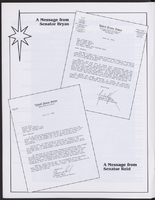Search the Special Collections and Archives Portal
Search Results

Meeting minutes for Consolidated Student Senate University of Nevada, Las Vegas, September 19, 1994
Date
1994-09-19
Archival Collection
Description
Includes meeting agenda, minutes, and information sheets regarding student health fees and related health facilities.
Text

Meeting minutes for Consolidated Student Senate University of Nevada, Las Vegas, March 3, 1997
Date
1997-03-03
Archival Collection
Description
Includes meeting agenda and minutes, along with additional information about referendums and letters.
Text

Meeting minutes for Consolidated Student Senate University of Nevada, Las Vegas, February 9, 1998
Date
1998-02-09
Archival Collection
Description
Includes meeting minutes.
Text

Meeting minutes for Consolidated Student Senate University of Nevada, Las Vegas, January 13, 1997
Date
1997-01-13
Archival Collection
Description
Includes meeting agenda and minutes.
Text

Interview with Stuart C. Black, February 21, 2006
Date
2006-02-21
Archival Collection
Description
Narrator affiliation: Scientist, U.S. Public Health Service; U.S. Environental Protection Agency REECo/Bechtel
Text

Interview with Jerome Alexander Zawada, August 9, 2006
Date
2006-08-09
Archival Collection
Description
Narrator affiliation: Franciscan Priest, Nevada Desert Experience
Text

Interview with James Nobuo Yamazaki, October 14, 2005
Date
2005-10-14
Archival Collection
Description
Narrator affiliation: Physician in Charge, Atomic Bomb Casualty Commission, Nagasaki
Text

Interview with Layton James O'Neill, July 23, 2004
Date
2004-07-23
Archival Collection
Description
Narrator affiliation: Health Physicist, U.S. Atomic Energy Commission; Department of Energy
Text

Holocaust Education Conference program, 1997
Date
1997
Archival Collection
Description
Booklet program from the Holocaust Education Conference, 1997.
Text
Pagination
Refine my results
Content Type
Creator or Contributor
Subject
Archival Collection
Digital Project
Resource Type
Year
Material Type
Place
Language
Records Classification

